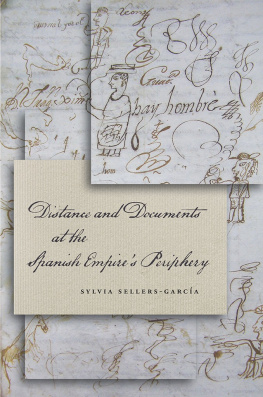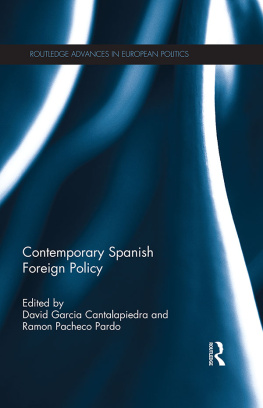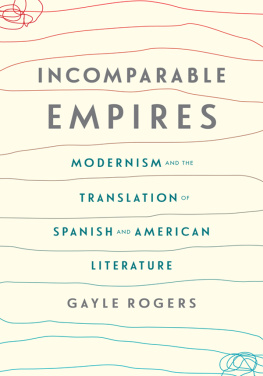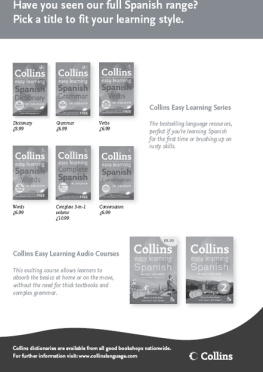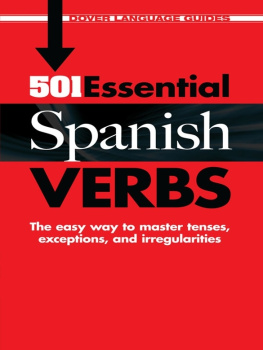Stanford University Press
Stanford, California
2014 by the Board of Trustees of the Leland Stanford Junior University.
All rights reserved.
This book was published with subsidized support from Boston College.
No part of this book may be reproduced or transmitted in any form or by any means, electronic or mechanical, including photocopying and recording, or in any information storage or retrieval system without the prior written permission of Stanford University Press.
Printed in the United States of America on acid-free, archival-quality paper
Library of Congress Cataloging-in-Publication Data
Sellers-Garca, Sylvia, author.
Distance and documents at the Spanish Empires periphery / Sylvia Sellers-Garca.
pages cm
Includes bibliographical references and index.
ISBN 978-0-8047-8705-5 (cloth : alk. paper)
1. Government publicationsCentral AmericaHistory. 2. Government publicationsSpainColonies. 3. Geographical perceptionSpainColonies. 4. Central-local government relationsSpainColonies. 5. Central AmericaHistoryTo 1821Sources. 6. SpainColoniesAmericaHistorySources. I. Title.
F1437.S45 2014
972.8'01dc23
2013021475
ISBN 978-0-8047-8882-3 (electronic)
Typeset by Bruce Lundquist in 10.5/12 Sabon
Acknowledgments
Archivists at the Bancroft Library in Berkeley, California, at the Archivo General de Centroamrica in Guatemala, at the Archivo General de Indias, and at the Centro de Investigaciones Regionales de Mesoamrica opened the doors to archival research and provided me with essential guidance. I am particularly grateful to the entire staff of the AGCA for their hospitality.
A summer fellowship from the Taft Center at the University of Cincinnati allowed me to complete the first draft of this manuscript, and the generous leave offered by Boston College during spring 2012 offered the much-needed time to embark on the necessary revisions. My thanks to Jim Cronin and David Quigley for making it possible. Audiences and readers at both of these institutions, audiences at other campuses, and participants at several conferencesparticularly those at the Sixteenth Century Society conferencegave valuable comments on portions of the manuscript.
I wish to thank Norris Pope of Stanford University Press for his energetic support of this project, which he has shepherded through to publication. My thanks also to Emma Harper for answering my many, many questions and keeping me on the right path. I am grateful to Judith Hibbard and Stacy Wagner for their assistance in the latter stages of publication. The anonymous reviewer who offered comments through Stanford University Press has helped to make this book more concise and, I hope, precise; I am grateful for the feedback. I am also indebted to Ken Mills for the extremely thorough and insightful comments that allowed me to see this manuscript in a much clearer light.
I am very grateful to friends, colleagues, and mentors from Berkeley and the Bay Area, including Jos Rabasa, Kerwin Klein, Russ Sheptak, Thomas Dandelet, Mark Healey, Linda Lewin, Richard Candida-Smith, Theresa Salazar, Carlos Delgado, Walter Brem, and David Kessler. Stephanie Ballenger, Laurence Cuelenaere, Kinga Novak, Jessica Delgado, Julia Sarreal, Brianna Leavitt-Alcntara, Beatrice Gurwitz, Marcelo Alejandro Aranda, Sarah Wells, Victor Goldgel Carballo, Heather Flynn-Roller, and Seth Kimmel all read some version of work included in this book, and I am grateful for their suggestions. Paul Ramrez has continually offered welcome challenges to the ideas, methods, and writing style of this manuscript; I have pushed further on many fronts because of his questions and suggestions. Alejandra Dubcovsky, ever a generous reader, has waded into this draft at multiple points, and I am particularly grateful for her comments on a late version of the Introduction. I especially want to thank Sean McEnroe for so whole-heartedly engaging in every aspect of this project. From the half-formed initial ideas to the more determined stylistic changes at the end, this manuscript has benefited at every turn from his advice.
From across the country or the state, Beatrice Bartlett, Jordana Dym, Randolph Head, and Bruce Castleman opened my eyes to new readings, sources, or ideas. Colleagues in the History Department at the University of Cincinnati, especially Maura OConnor, Sigrun Haude, and Wendy Kline, supported this manuscript at key moments when it was going through growing pains (or shrinking pains). Sarah Jackson offered feedback on the Introduction just before it was finalized. I am very grateful to Julie Gibbings, Carmen Valenzuela de Garay, Arturo Paz, and Ramiro Ordoez Jonama for their support in Guatemala. I particularly wish to thank Ramiro for his kindness in Guatemala City and for introducing me to Rivera Maestre.
Colleagues at Boston College have supported this project from the moment I arrived, not least by creating a lively and energetic environment in which talking about ones research is never an imposition. I am grateful to Robin Fleming for her guidance on both substance and practical matters. Heather Richardson, Marilynn Johnson, Virginia Reinburg, Sarah Ross, Dana Sajdi, and Prasannan Parthasarathi have offered ideas and encouragement in many ways. My warm thanks to Deborah Levenson-Estrada for her unbounded enthusiasm, for her friendship, and for the many fascinating conversations.
I am grateful to Margaret Chowning for challenging me early on to think about what historical writing should do and for offering comments particularly crucial to the organization of this manuscript. Her comments left me with a model for rigor that I will happily pursue for as long as I am writing. William B. Taylor sat down with me at the Bancroft Library in 2003 and pointed to the Inquisition case from Escuintla that became so many beginnings: the beginning of this book, the beginning of my longer investigation into distance and documents, and the beginning of my inexorable and entirely rewarding habit of historical thinking. I recall fondly how that page of eighteenth-century text came alive, a first instance of the many in which the past emerged as vivid but changeable, never wholly reconciled. I am deeply grateful for the continual inspirations, minute and monumental, that emerge from his mentorship.
Lastly, I wish to thank friends and family in the United States and in Guatemala for their continual encouragement. I am indebted to family members in Guatemala for supporting me in undertaking this project and many others, particularly Marina San Roman, Sergio Silva, and Igork San Roman. I would not have trekked across country to study history at Berkeley if Pablo had not promised (correctly) that there was no other place like it. My mothers enigmatic stories about family history first sparked my interest in understanding Guatemalas past, and my father has weighed in with ideas, books, and ponderable questions at every stage of my learning. Olivers boundless good humor, common sense, and wise counsel have kept me on track through many twists and turns over the last few years. My thanks to Alton for his ability to see remote things with such clarity that they are made near.

